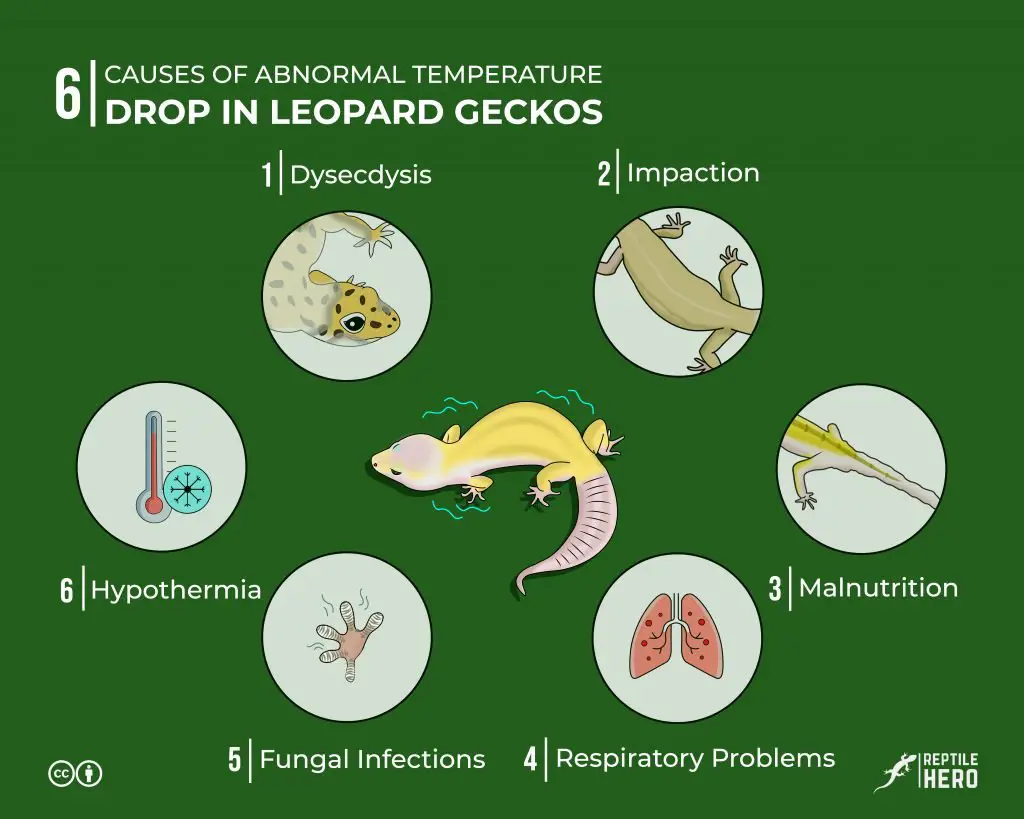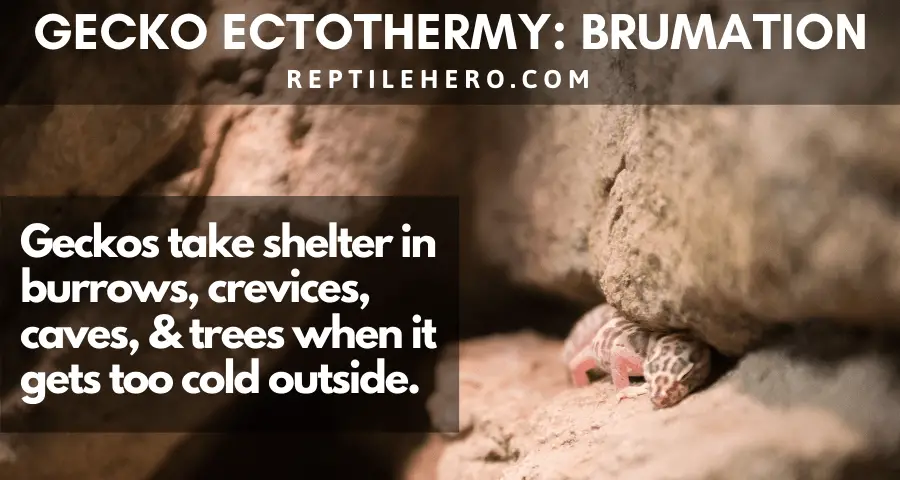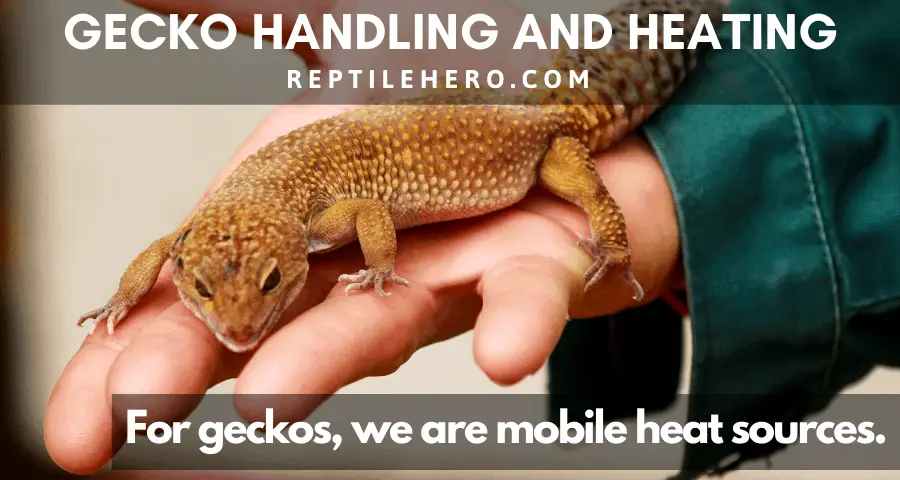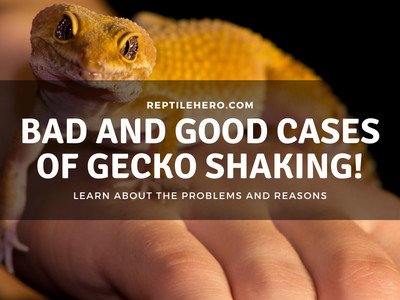Why Does Your Gecko Feel So Cold? [6 Potential Problems]
Because geckos are cold-blooded reptiles, many people planning to keep them for the first time do expect them to feel quite cool to the touch. However, actually feeling how chilly they can be by personally picking them up can still be shocking. And when exactly is their coldness normal and when is it dangerous?
Humans perceive geckos as cold creatures because they are ectothermic; they have lower body temperatures and they maintain their environments’ temperature. When unable to maintain preferred body temperatures due to lack of environmental heat, geckos will at best go into brumation and at worst experience hypothermia.

Cold-Blood: Mean & How Does It Work?
Geckos are cold-blooded animals: this is a fact most people know. Unfortunately, not everyone actually fully understands what that means and what it entails. This lack of understanding stems from the term itself and the misconceptions that come with it [1].
Ectothermy
Some people make the common mistake of thinking that “cold-blooded” animals, like geckos, are totally unable to control their body temperatures. They are made out to be feeble creatures incredibly weak to the slightest changes in substrate and ambient temperature, having no ability to save themselves from the cold and heat.
Geckos are ectotherms animals. Theycan safely infer that they depend on external sources of heat, like the sun in the wilderness, to maintain their preferred and/or optimal body temperatures [2].
So while they are, to some extent, sensitive to changes in temperature, it’s not because they are incapable of regulating their body temperature. It’s more because of the fact that they don’t produce their own body heat.
However, through something called thermoregulation [3], geckos can actually warm themselves up or cool themselves down simply by moving to a place that either has a higher or lower temperature compared to where they were previously staying at [4].
They move not to just feel comfortable but also to make sure that their body stays working normally. You see, since their body temperature plays a significant role in their metabolism, digestion, locomotion, feeding, and defending themselves from predators, they will look for a place that will give them the best shot at surviving – and even thriving.
Normal Body Temperature
By virtue of geckos being ectotherms, they have much cooler body temperatures compared to humans. The normal human body temperature is 97°F (36.5°C) to about 99°F (37.5°C). And unlike the geckos,humans generally maintain this body temperature regardless of the weather.
Geckos, in contrast, get heat from their surroundings. Considering that all gecko species have evolved in diverse types of natural habitats (arid deserts, rocky grasslands, humid rainforests, etc.), different species have different preferences when it comes to what body temperatures they maintain [5].
Crested geckos seem to thermoregulate until they get their body temperatures within the 75-82°F (24-28°C) range [6], quite comparable to the ambient temperature experienced in New Caledonia. While leopard geckos’ sweet spot when it comes to average preferred body temperature is around 77°F (25°C).
Now, compare your normal body heat from their preferred body heat. Big difference, no? So, the next time you find that your soft reptile baby feels a bit cool to the touch, don’t be surprised. It’s pretty normal and to be expected.
Here’s a quick video on thermoregulation in ectotherms vs. endotherms:
Cool Places
Our lovely soft-bellied little friends need a lot of care and attention. That’s why good husbandry is important and more experienced keepers and breeders advise newbies in the hobby to do as much research as they can into the specific breeds they are planning to get as pets.
One of the major things to look into, is, of course, temperature. And as I have already explained, geckos are highly dependent on their environment for heat. They rely on available heat sources – be it a type of heating unit or a light source that heats up considerably.
However, the other side of the coin also shows that they also seek shelter from the heat. So when they want to cool down, they move to areas with lower temperatures and also lower their body temperatures as a result.
Simply put: a warm place is to a warm body and a cool place is to a cool body. But, of course, they also have their limits.
Geckos can’t be in environments that are either above 90°F (32°C)or below 65°F (18°C) for prolonged periods otherwise serious problem such as dysecdysis, impaction and more might arise [7, 8].
Brumation

Geckos need to maintain a favorable range of body temperatures to ensure that all of their bodies’ physiological processes run smoothly and without a hitch. This is a relatively easy task for geckos originating from tropical countries. For species that originally live in temperate regions of the globe, it’s much more difficult especially during winter.
To ensure their survival during such a cold season, they slow down their metabolism and other internal processes. In this period, they will sleep a lot more and eat a lot less – sometimes even completely. Brumation is the term people use to refer to this innate survival tactic, oftentimes compared to the period of hibernation warm-blooded (endothermic) animals experience.
During brumation, terrestrial geckos like leopard geckos may retreat inside rotten logs, rock crevices, caves, or burrow into the ground below the frost line to avoid freezing to death. Arboreal geckos, like crested geckos, take shelter high up in the canopies, inside hollowed out old trees.
Although brumation is natural for some species, it doesn’t always happen to geckos when kept in captivity. I also wouldn’t recommend that you induce it unless you are planning to breed fattened-up adult geckos.
You might be wondering why I explicitly mentioned ‘fattened up adult geckos.’ Well, to tell you the truth, improper induction of brumation could easily kill geckos, particularly when they are still juveniles. In the wild, it’s actually a matter of survival of the fittest. So if an adult gecko with moderate fat deposits can die, imagine what could happen to young ones not old enough to build up a surplus of fat.
To learn more about brumation in geckos and other reptiles, here’s a good video:
6 Problems In Case of A Too Cold Gecko
Bad things are bound to happen when geckos get too cold for comfort. When environmental temperatures fall way below their preferred body temperatures – or worse, below temperatures considered safe for brumation (65°F or 18°C at the lowest) – they become incapable of accomplishing basic activities for growth, feeding, and reproduction among other things. As you may imagine, this comes with numerous complications [11].
#1 – Dysecdysis
In a previous article, I’ve briefly touched on how dehydration can result in the retention of shed skin. Other causes of dysecdysis also include lack of humidity due to lower temperatures. As the weather gets cold, the air becomes drier. This can be a big problem in relation to shedding.
To prevent this from happening, keep an eye on your humidity levels. If lower than what is needed, place a dish of water in your gecko’s enclosure or add some terrarium moss and/or live plants in their vivarium. Also, make sure to give them a humid hide so they can voluntarily go there when they need to.
If you spot a retained shed, let your gecko soak in lukewarm water or wrap your gecko in a damp towel a few times a week to help soften it for easier removal.
#2 – Impaction
When geckos get too cold regularly or for a single extended period, their metabolism slows down so they cannot efficiently digest and process the food they consume. This is especially troubling considering that they already have relatively slow rates of digestion.
If this happens to your beloved pet gecko, don’t handle him too much as that would add to their discomfort. Others have suggested that you give your gecko a gentle belly massage but I would instead advise you to visit your exotic vet. Leaving impaction untreated by a professional could easily lead to your gecko’s death.
#3 – Malnutrition
Because geckos slow down to conserve the remaining heat they have in their bodies when they get too cold, they are at risk of experiencing malnutrition. They become unable to hunt for and process food [7].
For the most part, this happens to geckos who enter brumation without enough fat reserves. Gecko species with fatter tails, including leopard geckos, are forced to live off the inadequate reserves they have in their tails ending up with stick tails.
Another contributing factor is the fact that there are virtually no live feeder insects available for foraging in the wild when winter comes. So even if they wake up in the middle of winter, they have nothing to eat other than any other reserves they might still have in their bodies. Their overall body mass significantly falls and they start looking like nothing but skin and bones.
#4 – Respiratory Problems
Prolonged exposure to cold and dry environments can also cause respiratory infections in geckos such as pneumonia. Low temperatures along with a dirty vivarium will for sure cause problems.
Look out for the signs and symptoms of respiratory diseases in geckos which include lethargy, gaping, breathing difficulties, and clogged or dripping noses. If you notice any of these in your gecko, immediately call your vet for an appointment so its condition doesn’t worsen. They will most likely prescribe an antibiotic and advise you to raise the temperature inside your gecko’s home to help boost its immune system.
If not immediately and properly treated by a professional, your gecko runs the risk of developing septicemia, an infection in its bloodstream [7].
#5 – Fungal Infections
Continued exposure to the cold can also lead to the development of fungal diseases. What’s incredibly scary in such situations is that there is still limited knowledge on the topic and it may go unnoticed in some animals as they continue to eat normally despite it. All the damage happens inside and isn’t readily observable.
Some researchers have pointed out two possible signs of fungal infection: inflammation and discoloration in the skin as well as weight loss with no apparent reason.
However, the most frequent site of infection, other than the skin, is the respiratory tract. So prevention is better than cure – especially because there are very few cases of successful treatment for this condition as the specific causes and progression are still largely unknown. Have your gecko feed on a healthy and balanced diet and regularly clean and disinfect their tanks.
#6 – Hypothermia
At a certain drop in temperature, to levels much lower than even those experienced during brumation, geckos don’t just slow down they may actually come to a complete halt. In fact, many cases of pet reptiles sent to emergency units are usually hypothermic.
Because they are not getting enough heat from their surroundings to maintain an optimal body temperature, they are at high risk of developing all the previous conditions I have already mentioned [7].
This is especially common for pet geckos living in countries that may experience power outages due to heavy snowfall and strong winds.
Top Tips To Make Sure Your Gecko Don’t Get Too Cold
Like I said, geckos are immensely reliant on external sources of heat to function properly. To make sure your gecko can thrive while in your care, you can do the following:
- Invest in a good heat source. In recent years, more and more keepers are recommending halogen bulbs (here on Amazon), ceramic heat emitters (CHE) (here on Amazon), and deep heat projectors (DHP) as better choices over the traditional under tank heaters (UTH).
- Have a dimming thermostat to control your tank temperatures.
- Set a cool side and warm side for your gecko for efficient thermoregulation [9].
If you’ve got a lot of questions and misgivings about DHP, you can watch this video to get your answers:
However, simply giving them a good heat source in their enclosures with a temperature gradient to allow for normal thermoregulatory behavior [10] may not be enough in all instances.
Most keepers living north of the equator would probably attest to the fact that power outages during blizzards are a legitimate cause of concern. To keep your reptiles safe and warm even in the absence of power, you can do the following:
- Insulate their tanks with cork panels, bubble wrap, polyethylene sheets, or polystyrene foam (more commonly known as Styrofoam).
- Wrap them loosely in a clean blanket or towel.
- Keep battery-powered heat sources like lamps and pads.
- Create makeshift heat pads using hot rice in clean old socks.
- Have a few hot packs in stock (here on Amazon).
Does Handling Heat Them Up?

In the same way that what’s cool to us may be perfectly all right for them, what’s warm for us can be scalding hot for them. So does this mean that handling them is bad? Not necessarily.
When you take your gecko out of its enclosure, into an open room, they will be out of their controlled and preferred temperature gradient. But since you are can be considered as a heat source – being 97°F (36.5°C) to about 99°F (37.5°C) – they will do just fine.
For geckos, being handled, if done properly, is welcomed as a way to have the extra heat that are missing out of their enclosure.
As a matter of fact, many hobbyists will happily share stories of their cute little geckos snuggling up to them for warmth. Given that they are neither too cold nor too hold in your hands, they will generally happily stay in your embrace.
However, if they get too hot from your touch or too cold because of the room temperature, they will let you know by trying to get away from your reach. There is also no clear time limit for how long handling sessions should be but I’d say it’s always best to keep it short.
Takeaways
- Geckos feel chilly upon handling because they are ectothermic animals; they have lower body temperatures and they maintain their environments’ temperature.
- When unable to maintain preferred body temperatures, geckos will go into brumation and live off their collected fat reserves.
- Prolonged exposure to dry air and low temperatures puts geckos at a certain risk of experiencing dysecdysis, impaction, malnutrition, respiratory problems, fungal infection, and hypothermia.
- To make sure your gecko doesn’t get too cold, make sure to set up a temperature gradient in their enclosures. In cases of a power outage, numerous safety precautions and alternative heat sources are available.
- Handling geckos in open rooms (with lower temperatures compared to their enclosures) could give them some heat, but to make sure that they don’t get overheated it’s best not to keep them out of their tanks for too long.
Sources
- http://reptilis.net/myths.html
- https://zooatlanta.org/cold-blooded-whats-it-mean/
- https://www.timsreptiles.co.za/reptile-facts/how-reptiles-maintain-their-body-temperaturehttps://www.merckvetmanual.com/all-other-pets/reptiles/providing-a-home-for-a-reptile
- https://www.petmd.com/reptile/conditions/systemic/hypothermia-reptiles
- https://onlinelibrary.wiley.com/doi/abs/10.1002/jez.2388
- https://www.merckvetmanual.com/all-other-pets/reptiles/disorders-and-diseases-of-reptiles
- https://pubmed.ncbi.nlm.nih.gov/16031765/
- https://milwoodanimalclinic.com/reptile-husbandry
- https://pubmed.ncbi.nlm.nih.gov/31128638/
- https://www.britannica.com/animal/reptile/Chemoreception#ref38479

![Do Leopard Geckos Like Blankets? [Best Fabrics]](https://www.reptilehero.com/wp-content/uploads/2021/05/word-image-768x576.png)


![Do Geckos and Reptiles Dream in Their Sleep? [What Science Says]](https://www.reptilehero.com/wp-content/uploads/2021/07/Gecko-Sleeping-Infographic-768x614.jpg)
![Are Terrariums and Vivariums the Same? [6 Differences]](https://www.reptilehero.com/wp-content/uploads/2021/06/Terrarium-vs-Vivarium-768x614.jpg)
